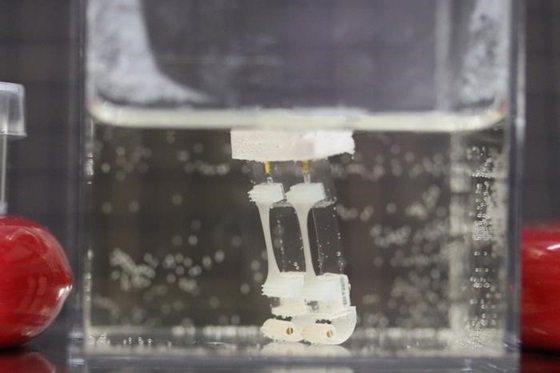Researchers at the University of Tokyo have unveiled a biohybrid robot that combines biological muscle with an artificial skeleton, demonstrating the capability to walk and pivot underwater. This innovation, led by Professor Shoji Takeuchi of the Graduate School of Information Science and Technology, marks a significant stride in the field of robotics, particularly in creating machines that closely mimic human locomotion.
Published in the journal Matter on January 26, the research team’s work focuses on overcoming the limitations of typical biohybrid robots, which until now, could only move in straight lines or execute large turns. This restricted their utility in environments dense with obstacles, such as those encountered in search and rescue operations. The new robot, however, can pivot on one foot, enabling it to turn within a small radius.
The robot’s design involves lab-grown skeletal muscle tissue attached to flexible artificial legs with 3D-printed feet. The muscle tissue, which loses its ability to move when dry, necessitated the robot’s operation in water. To construct the robot, the team used a lightweight styrene board for buoyancy, a silicone-based body for flexibility, acrylic resin legs with brass wire weights, and 3D-printed feet. Muscle tissues were grown in molds to create strips, then attached from the robot’s body to the feet.
Electrical stimulation, similar to the brain’s signals to the body, is used to control the robot’s movement. By delivering charges through hand-held gold electrodes, the muscle tissue contracts, allowing the robot to walk. Alternating stimulation between the legs at five-second intervals enables the robot to move at a speed of 5.4 millimeters per minute. While this speed may not seem rapid, it is comparable to other biohybrid robots.
The team’s achievement in facilitating bipedal walking was initially uncertain but ultimately proved successful, balancing muscle contractile force, the restorative force of the flexible body, gravity, and buoyancy. This accomplishment was met with excitement in the laboratory, marking a significant advance in biohybrid robotics.
Looking forward, the researchers aim to create a smoother-moving robot capable of walking on land. This involves developing remote muscle stimulation methods, thicker muscles with nutrient supplies, and potentially incorporating artificial skin. Additional goals include designing robots with joints and more muscle tissues to enable sophisticated walking capabilities.
This research offers valuable insights into the advancement of soft, flexible robots powered by muscle tissue and contributes to a deeper understanding of biological locomotion mechanisms. By drawing inspiration from human gait, the Tokyo-based team is not only pushing the boundaries of robotics but also paving the way for future innovations that more closely resemble the intricacies of human movement.
Photo: credit Shoji Takeuchi research group, University of Tokyo

